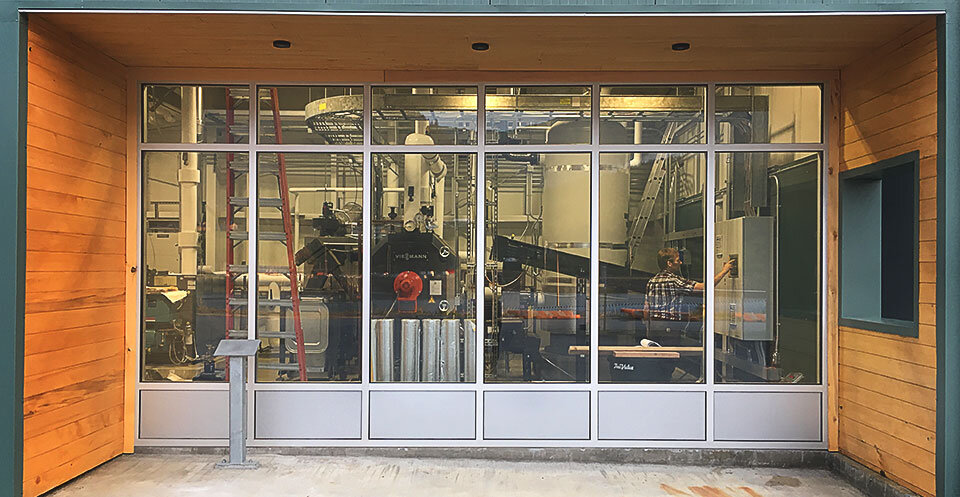LEVEL 40
SOLUTION: SPACE HEATING
LOCATION: KETCHIKAN, AK
FUEL: WOOD PELLETS
HIGHLIGHTS: For this project, an old fish storage area was converted into a beautiful mechanical room to house the biomass boiler, complete with a floor-to-ceiling viewing window for travelers to enjoy.
Ketchikan International Airport, the fourth-largest airport in Alaska, changed to biomass technology to heat its 33,000-square-foot space. Now, the biomass boiler serves as an ambassador for biomass efforts in Alaska.
THE STORY
Gravina Island epitomizes rugged, maritime Alaska. The water-locked island in the chilly southeastern part of the state is accessible only by ferry or aircraft. Despite its isolation, the island is home to Ketchikan International Airport — the fourth-largest airport in Alaska, which carries about 222,000 people on commercial flights each year. The airport was built in 1969 and has always depended on fuel oil to heat its 33,000-square-foot space. That is, until airport manager Mike Carney started researching biomass.
"We knew we wanted alternative energy, but given the fact that our community's electricity comes from hydropower, we didn't want to put a strain on the system," said Carney. In 2012, with a little ingenuity — and help from Ketchikan Gateway Borough — the airport secured grant money for a feasibility study.
Once started, the project quickly picked up momentum, earning federal and state grant money from agencies like the Alaska Wood Energy Development Task Group and the United States Forest Service. In 2015, Carney met Wisewood Energy founder Andrew Haden at a woody biomass conference in Fairbanks, Alaska. Soon after, Wisewood Energy began designing and constructing the $1,200,000 project.
“We’re just so proud of this project because it’s an example of how you can create a regional economy."
— Devany Plentovich, program manager for biomass and heat recovery with Alaska Energy Authority
In the end, Ketchikan Gateway Borough paid $50,000 for the project. Construction included renovation of an old fish storage building into the new boiler building, a 700-gallon thermal storage tank to increase efficiency and a silo that holds about 30 tons of pellets. Crews finished construction in May 2016.
"We like the fact the wood pellets are a smart way to use what’s leftover from another industry," Carney said. "Part of our goal, also, was to create another private enterprise in our community."
The pellets are made on the island at Tongass Forest Enterprises, a locally owned wood products manufacturer that builds saunas and greenhouses. Carney said the airport spent $70,000 annually to heat the campus with oil, but it projects spending just $30,000 annually for pellets. Carney said the entire process and partnership with Wisewood Energy has been seamless.
"Wisewood Energy has learned from mistakes made in the industry and we feel that we will be a success story," said Carney.
The success story continues to be written. Ketchikan International Airport's new boiler room will serve as an ambassador of sorts for biomass efforts in Alaska. A large window at the front of the building will allow airport visitors to view the biomass system and learn about the process through an infographic.
“We’re just so proud of this project because it’s an example of how you can create a regional economy,” said Devany Plentovich, program manager for biomass and heat recovery with Alaska Energy Authority, a funder of the project. “People will be able to see this as they’re traveling through the city. Maybe we can expand biomass even more in the state.”

“Our goal is to promote biomass within our state. People have a misunderstanding that oil is so cheap and don’t see biomass’s advantages. We view it as an alternative energy source that should be used across the United States.”
— MIKE CARNEY, KETCHIKAN INTERNATIONAL AIRPORT MANAGER
Space Heating
In addition to providing dramatic cost savings, biomass heating can integrate with most heat distribution systems, making it an easy conversion.




